Creating a Binaural Head recording system
To create a project where high quality audio and it's spacial relationship are key to success, using the right equipment is vital. For this project the team was attempting to create an entirely new genre, so much of the work was ground breaking. One important aspect of creating the environments required for this project was to produce totally immersive audio. This is a good step for any quality game title, but for a project created without visuals it was essential.
Binaural recordings are stereo recordings that, because of their nature, give the illusion of a surround recording. The primary method of producing a binaural recording uses a "dummy head". The head has correctly formed outer ears, with a very small microphone placed inside the ear canal. The shape of the ear causes sound waves to be reflected onto the microphone diaphragm in the same way they reflect onto the human ear drum. The shell of the ear and the various structural ridges cause minute delays in sound waves coming from different directions. This is how humans can identify a sound coming from the left or right or behind, and even detect angular variations.
For this project the team undertook to create their own binaural recording system.
Binaural recordings are stereo recordings that, because of their nature, give the illusion of a surround recording. The primary method of producing a binaural recording uses a "dummy head". The head has correctly formed outer ears, with a very small microphone placed inside the ear canal. The shape of the ear causes sound waves to be reflected onto the microphone diaphragm in the same way they reflect onto the human ear drum. The shell of the ear and the various structural ridges cause minute delays in sound waves coming from different directions. This is how humans can identify a sound coming from the left or right or behind, and even detect angular variations.
For this project the team undertook to create their own binaural recording system.
Head Construction
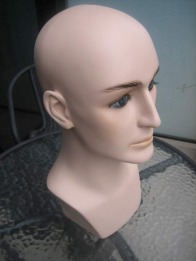
Commercially available binaural dummy heads can be extremely expensive. This is mainly because they contain very high quality professional microphones. The construction of the head is also important, but less critical than the choice of mics. By already having access to very high end small mics, it was not difficult to produce a working dummy head. The head itself could be constructed from a a shop mannequin head as long as the outer ear structure was a good approximation of a human ear.
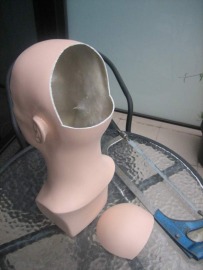
As the microphones needed to be mounted inside the head and other structural modifications were needed it was necessary to gain good access tot he insides of the head. The large opening allowed for easy access and modification of the head. All the work done on the head structure was completed with standard household hobby tools. There was no unusual equipment needed, but the entire process was carefully planned before any construction was started.

The ears were the most important area to construct correctly. holes needed to be positioned carefully, and the outer ear surface had to be clear of imperfections that could effect sound reflection.
The entire process was reliant on producing a reasonable replica of the human ear canal system
The entire process was reliant on producing a reasonable replica of the human ear canal system
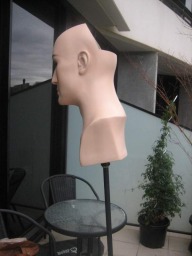
The head was adapted to allow it to attach to any standard microphone stand or mounting system. In this way the dummy head could be utilized in any situation where a standard microphone could be used. Maximising the flexibility of it's use ensures a new piece of equipment can be used to it's fullest potential.
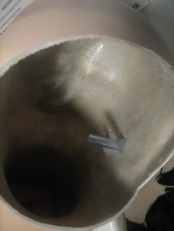
Simulated ear canals not only provide a location in which to mount the miniature microphones, but continue to focus sound waves into the ear in the same manner as a real human ear. The clear tubing allows the user to see the exact position of the microphone inside the canal and adjust as required.

A human head is not hollow, and neither should a dummy head be. The internal material prevents the head from having a hollow or echo chamber effect on the recorded sound. The choice of filler is not important, but the lighter the material the easier it is for the user. The choice of material can also effect how durable the head will be with use over time.
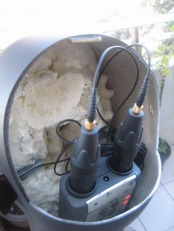
Allowing space inside the head for the chosen recording device will allow the entire unit to be sealed and self contained. There are a variety of reasons why this might be desirable. As with the filler material, the choice of microphones and recording device are up to the individual. The important factors are quality of sound and usability of the end product.
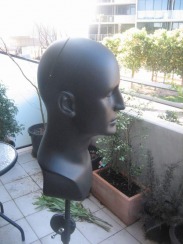
The final result is a piece of recording equipment that is capable of simulating the human hearing system and reproducing this effect in a stereo sound file. The device itself is lightweight and fairly easy to transport. Set-up time is minor and the results so far have been very promising. This equipment is not attempting to replace a professional dummy head recording system of many thousands of dollars, it does however reproduce an accurate simulation of human hearing in a binaural field.
